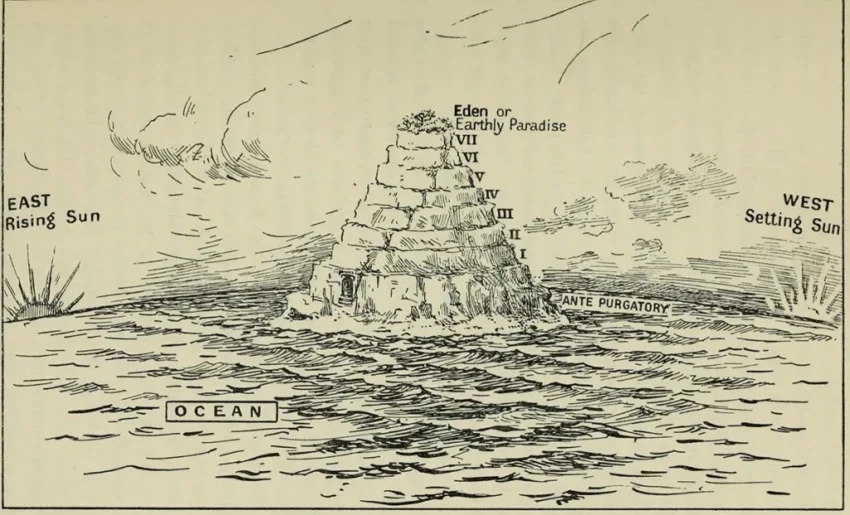Dante Alighieri’s (1265-1321) treatment of the Seven Deadly Sins and their corresponding Seven Heavenly Virtues in the Purgatorio is one of the most influential artistic representations of the seven-seven moral schema: Dante structures the mountain of Purgatory with seven terraces, each dedicated to purging one of the capital sins and cultivating its opposing virtue, and arranges the sins from most grave (pride, at the bottom) to least grave (lust, at the top) – with souls ascending as they’re purified. At each terrace, souls experience examples of the virtue, examples of the sin being punished, a specific purgative punishment, a beatitude and prayers, and an angel who removes one “P” (peccatum/sin) from Dante’s forehead.
The First Terrace Of Purgatory: Pride Is Purged Through Humility
On the First Terrace, Pride is purged through Humility. The proud carry enormous stones on their backs, forcing them to look downward in humility. Dante sees carved into the pavement examples of humility: the Annunciation showing Mary’s humility, David dancing before the Ark, and Emperor Trajan’s justice to a widow. Examples of pride punished are also carved in the floor where the proud must look: Satan’s fall, the Giants’ rebellion, Niobe’s arrogance, and Saul’s disobedience. Dante teaches that pride is the root of all sin, making it appropriate for the first terrace. The proud must learn “how small we are” (Purgatorio X-XII). The beatitude here is “Blessed are the poor in spirit.”
The Second Terrace Of Purgatory: Envy Transforms Into Charity
The Second Terrace transforms Envy into Charity. The envious have their eyes sewn shut with iron threads, unable to see others’ good fortune that once caused them sorrow. Voices cry out examples of charity including Mary at Cana saying “They have no wine,” the friendship between Orestes and Pylades, and Christ’s command to “Love those who harm you.” Examples of envy punished include Cain’s fratricide and Aglauros turned to stone for envying her sister. Dante teaches that envy sees others’ good as diminishing one’s own. The cure is recognizing that heavenly goods multiply when shared: “The more there are who say ‘ours’ up there, the more each has of good” (Purgatorio XV). The beatitude is “Blessed are the merciful.”
The Third Terrace Of Purgatory: Wrath Gives Way To Patience
On the Third Terrace, Wrath gives way to Patience. The wrathful walk in blinding smoke, reciting the Agnus Dei (“Lamb of God”). Dante experiences visions of patience: Mary’s gentleness finding Jesus in the Temple, Pisistratus’s clemency, and Stephen’s forgiveness while being stoned. Examples of wrath punished include Procne’s vengeful infanticide and Haman’s rage leading to his downfall. Dante teaches that wrath clouds judgment like smoke clouds vision. Marco Lombardo delivers a crucial discourse on free will and moral responsibility here. The beatitude is “Blessed are the peacemakers.”
The Fourth Terrace Of Purgatory: Sloth Converts Into Zeal
The Fourth Terrace converts Sloth into Zeal. The slothful must run continuously, shouting examples of zeal and sloth. Examples of zeal include Mary’s haste visiting Elizabeth and Caesar’s military swiftness. Examples of sloth punished are the Israelites who died in the desert and the Trojans who stayed in Sicily rather than following Aeneas. This is the central terrace, where Virgil explains the structure of sin as disordered love. Sloth is deficient love of good. The souls shout: “Haste! Haste! Let no time be lost through little love!” (Purgatorio XVIII). The beatitude is “Blessed are they who mourn.”
The Fifth Terrace Of Purgatory: Avarice Transforms Into Liberality
The Fifth Terrace transforms Avarice into Liberality. The avaricious lie face-down, contemplating earth they once coveted, reciting examples of poverty and liberality. Examples of liberality include Mary’s poverty at Christ’s birth, Fabricius’s incorruptibility, and St. Nicholas’s generosity. Examples of avarice punished include Pygmalion’s fratricide for gold, Midas’s fatal wish, and Achan’s theft of war spoils. Hugh Capet delivers a fierce denunciation of royal greed. The earthquake that shakes Purgatory occurs here when Statius completes his purgation. The beatitude is “Blessed are they who hunger and thirst for justice.”
The Sixth Terrace Of Purgatory: Gluttony Becomes Temperance
On the Sixth Terrace, Gluttony becomes Temperance. The gluttonous suffer hunger and thirst while passing trees with unreachable fruit and water. Voices from the trees cite examples of temperance: Mary’s moderation at Cana, Daniel’s abstinence, and the Golden Age’s simple diet. Examples of gluttony punished include the centaurs’ drunken violence and Gideon’s soldiers who drank greedily. The emaciated souls sing “Labia mea, Domine” (“O Lord, open my lips”). Forese Donati explains how their punishment creates desire that brings pain yet satisfaction through conformity to Christ’s suffering. The beatitude is “Blessed are they who hunger for righteousness.”
The Seventh Terrace Of Purgatory: Lust Is Purified Into Chastity
The Seventh Terrace purifies Lust into Chastity. The lustful walk through purifying flames while shouting examples of chastity and lust. Examples of chastity include Mary’s virginity (“I know not man”), Diana’s purity, and wives and husbands faithful to marriage vows. Examples of lust punished include Sodom and Gomorrah and Pasiphaë’s bestiality. Here Dante meets the poets Guido Guinizelli and Arnaut Daniel. All souls must pass through these flames to reach Paradise – including Dante himself, suggesting all humans must purify sexual desire. The beatitude is “Blessed are the pure in heart.”
Then What Happens?
After the seven terraces, Dante enters the Earthly Paradise (Eden), where he meets Beatrice representing Divine Wisdom/Theology, witnesses a pageant of salvation history, drinks from Lethe (forgetting sin) and Eunoe (remembering good), and becomes ready for Paradise. Dante’s genius lies in synthesizing theological doctrine with classical literature and contemporary events, psychologizing the purgative process by showing how souls actively participate in their purification, demonstrating that the virtues aren’t mere opposites but transformations of the same fundamental energy of love, and creating vivid, memorable images that made abstract theology concrete. His presentation profoundly influenced how Western culture visualizes the relationship between sin and virtue, making the seven-seven pairing canonical in art, literature, and popular understanding.
Thanks for reading!
